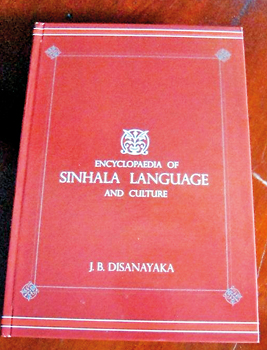Sinhala with all its nuances for the English reader
Professor J.B. Disanayaka is well known for his innovative creations. His latest book is no exception. The ‘Encyclopaedia of Sinhala Language and Culture’, he himself says is of “an unusual kind”.
JB says his work differs in at least four ways from the traditional encyclopaedia. Firstly, it presents facts thematically and not alphabetically, as is the usual form.
The themes do not embrace everything but cover only aspects related to Sinhala language and culture. All contributions are by the same author – that is, himself, and lastly, there is an underlying theme that brings all the essays together – the intrinsic link between language and thought. So before the reader starts he knows exactly what to expect.

The near 800-page publication has 25 essays with several units. For example, in the essay titled ‘Sinhala – a living language’, there are 13 units ranging from topics like Sinhala and Sinhalese (“Sinhala is the language spoken by the Sinhalese, the largest ethnic group in Sri Lanka”), Sinhala: Spoken & Written; Sinhala: Modern & Classical; Spoken Sinhala; Standard Sinhala; Sinhala Slang; Sinhala Baby talk: Singlish and so on. These units cover all aspects of a topic in question “almost in an encyclopaedic spirit.”
I was intrigued to find out how he explains ‘Singiris’. The Sinhala words used for vehicles are basically English ones with the addition of ‘ekak’ like’ bus-ekak’ and ‘car-ekak’. It’s the same with verbs when the word ‘karanawa’ – as in ‘cancel-karanava’ and ‘start-karanava’ – is added to the English word.
As for Sinhala slang, JB quotes from what students in schools and undergrads in the campus use. ‘Principal’ is ‘pina’, a friend is a ‘pora’ (‘maara porak’ which JB terms “the most outstanding term”), and the commonest superlatives are ‘maaara’ and ‘niyamay’ (fantastic). The undergrads create some of their slang by shortening the English words – like ‘Profa’ for ‘Professor’.
He gives examples of how Standard Sinhala takes a new face in the campus. The standard term ‘dakkanava’ (to drive – like cars) in campus slang is ‘to go about with a lover’; ‘aninava’ (to pierce) is ‘to put another into trouble’; ‘kaduva’ (sword) for English language’. A lecture is described as either ‘sira’ if it is good or ‘anjabajal’ if it is bad. A new batch is a ‘neva’ which unloads ‘badu’ – the latter referring to girls. They come in various shapes ranging from ‘tois’ for a good-looking one to ‘goraka’.
Decades ago we used virtually the same terms but the vocabulary has certainly increased over the years. Of course, unlike JB, we didn’t care to make a study of the campus slang!
I was fascinated by JB’s thesis on ‘Sri Lanka – the super-nation that was’. JB states that two factors contributed to the rise of the Sinhalese: their knowledge of mathematics and their language that encoded this knowledge in precise terminology.
How does JB conclude that the Sinhalese were among the greatest mathematicians of the ancient world? He gives just two facts. One is their own system of numerals, containing a zero. The other is that they counted in sets of twelves as the ancients did.
He says that the Sinhalese system of numerals is far superior to the Roman numerals because of using a zero, which is “a great leap forward in mathematical thought”. The system of numerals and the mathematical thought based on it made the Sinhalese produce a civilization that was on par with any other great civilization in the Ancient World such as that of China, India, Babylonia, Egypt, Greece and Rome.
JB also delves into the ‘duo-decimal system’ – counting in twelves – as against the ‘decimal system’ where we count in tens. The evidence that the ancient world used the duo-decimal system comes from the sets of twelve we still use. In measuring time, 12 has been the dividing line. A year has 12 months, a day has 12 hours and so does the night. Twelve marks the middle: midday and midnight dawn at 12 o’clock. An hour has 60 (12×5) minutes and a minute has 60 (12×5) seconds.
The zodiac is divided into 12 ‘signs’. In measuring space, 12 has become equally important because a foot has 12 inches. He gives many more examples.
JB considers the discovery of the exact centre of Sri Lanka is an achievement by the Sinhalese. The centre is located in the village of Nalanda about a kilometre off the main road that links Matale and Dambulla. The name ‘nalanda’ denotes a ‘landa’ (thicket) of ‘na’ trees. The famous Nalanda ‘gedi-ge’ is built at the exact location.
The Sinhalese reached exceptional heights in hydraulic engineering due to their exceptional knowledge of mathematics. The invention of the valve-tower (biso kotuva), the construction of the sluice at Maduru Oya reservoir and the 5th century canal taking the water from Kala Weva to Tissa Weva have been quoted as examples.
This is only a glimpse of JB’s effort to cover the progress of a nation’s language and culture in a most readable manner. He has succeeded in his rather ambitious project. He can be more than happy that he has provided the English reader with a well compiled publication on the nature, structure, origin and development of the Sinhala language, and the patterns of thought of the Sinhalese and the way they expressed themselves in their language.
Follow @timesonlinelk
comments powered by Disqus


























